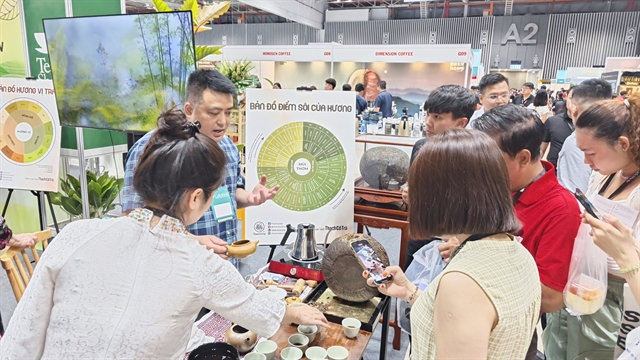 Economy
Economy

 |
| Visitors taste a Thạch Cổ Trà tea product at a recent show in HCM City. — Photo nld.com.vn |
HÀ NỘI — Domestic companies are being encouraged to produce high-quality tea products, such as specialty teas, to serve local consumption and service demand for exports.
In the 2018-23 period, Việt Nam exported between 125,000 and 140,000 tonnes of tea each year, bringing in a turnover of US$220-240 million per each, according to the Vietnam Tea Association.
During the period, some enterprises had provided high-end tea products with prices ranging from $15,000 to over $50,000 per tonne, much higher than the average export price of Vietnamese tea at only $1,700-1,800 per tonne. However, the ratio of these quality tea products remained low.
General Director of IGV JSC which owns Thạch Cổ Trà brand, Nguyễn Đăng Bền, said that the revenue of the Vietnamese tea industry mainly comes from green tea and black tea, which are low-value tea products, so the industry's revenue is low and producers do not have high profits.
Bền told Người lao động (Labourer) newspaper that he has chosen to invest in the specialty tea of ancient trees of the primaeval forest. These tea products are processed within five hours of harvesting. Thanks to the fermentation method, the longer the tea products are stored, the more value they will have, he said.
According to Bền, China has been very successful with Pu'er tea and the Chinese specialty tea market is worth up to $35 billion each year. He added that Pu'er tea is a tea product that bring higher profits than others, as it is also bought for collecting and investment purposes.
The founder of Thạch Cổ Trà - a unique fermented tea product that can maintain its flavour for centuries - said he believed that the Vietnamese specialty tea market could reach a scale of $3.5 billion each year based on a population of 100 million people, with many similarities to that of China.
Specialty tea can also be exported to bring in large amounts of foreign currencies, Bền said, adding that to do this, it is necessary to protect, care for and preserve the unique primaeval tea forests, which are only in five countries in the world, Việt Nam, China, Laos, Myanmar and Thailand.
Chairman of Tây Bắc Tea and Special Food Co, Phạm Vũ Khánh, which owns the Shanam tea brand, said that Việt Nam is home to about 20,000ha of ancient tea trees, considered the largest in the world.
Ancient tea has high economic value thanks to its many valuable medicinal properties, with selling prices reaching from VNĐ2.5 million to VNĐ25 million per kilo.
After gaining success in the north, Khánh said, his company is penetrating into the south, tapping into the high-end gift segment.
The company does not just sell tea products but it has teamed up with tourism companies to provide travellers with tour packages to ancient tea growing areas, in an attempt to improving the livelihoods of people in these areas, Khánh told the paper.
Earlier, the Ministry of Agriculture and Rural Development identified tea as one of the six key industrial crops by 2030, covering an area of about 120,000-150,000ha.
Over the past eight months of this year, Việt Nam shipped 92,280 tonnes of tea for over $162 million, up 30 per cent in both volume and value. Among some export markets that saw a sudden growth were Iran, up 2,720 per cent, and China, up 240 per cent.
A study by Research and Markets showed that the global tea market is expected to reach $37.5 billion in 2025, up from $24.3 billion in 2016.— VNS




